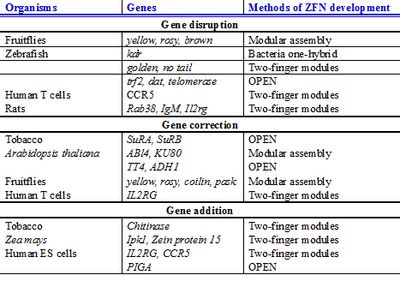تعديل الجينوم
تعديل الجينوم, Genome editing أو تعديل الجينوم بالنيوكليازات المهندسة (GEEN)، هو أحد أنواع الهندسة الوراثية يم فيها إدماج، استبدال، أو إزالة الدنا من الجينوم باستخدام النيوكلييزات nucleases المهندسة اصطناعياً، أو "المقص الجزيئي". تخلق النيوكلازات فاصل مزدوج الجديلة (DSBs) في الأماكن المرغوبة بالجينوم، وتسخر آليات الخلية الموضعية لإصلاح الفاصل المسبب من خلال المعالجات الطبيعية بالتأشيب المتماثل والضم الطرفي الغير متماثل. يستخدم حالياً أربع عائلات من النيوكلازات المهندسة: نيوكلييز إصبع الزنك، Transcription Activator-Like Effector Nuclease، نظام كريسپر/كاس، والميگانيوكلاز المهندس.[1][2][3]
يستخدم تعديل الجينوم في التحليل الوراثي بهدف معرفة وظائف الجين أو الپروتين عند تداخله معه بطريقة متسلسلة-معينة ومراقبة تأثيراته على العضية.[4]
خلفية
استهداف الجينات
العملية
Double strand break repair
النيوكلييزات المهندسة
التطبيقات
Meganucleases
نيوكلييزات أصابع الزنك
TALEN
CRISPR
دقة وكفاءة النيوكلييزات المهندَسة
Multiplex Automated Genomic Engineering (MAGE)
التطبيقات
Targeted gene modification in plants
العلاج الجيني
Eradicating diseases
Prospects and limitations
Human enhancement
المخاطر
In the 2016 Worldwide Threat Assessment of the US Intelligence Community statement United States Director of National Intelligence, James R. Clapper, named genome editing as a potential weapon of mass destruction, stating that genome editing conducted by countries with regulatory or ethical standards "different from Western countries" probably increases the risk of the creation of harmful biological agents or products. According to the statement the broad distribution, low cost, and accelerated pace of development of this technology, its deliberate or unintentional misuse might lead to far-reaching economic and national security implications.[5][6][7] For instance technologies such as CRISPR could be used to make "killer mosquitoes" that cause plagues that wipe out staple crops.[7]
انظر أيضاً
- Germinal choice technology
- CRISPR/Cpf1
- NgAgo, a ssDNA-guided Argonaute endonuclease
- هندسة الجينوم
المصادر
- ^ Esvelt, KM.; Wang, HH. (2013). "Genome-scale engineering for systems and synthetic biology". Mol Syst Biol. 9 (1): 641. doi:10.1038/msb.2012.66. PMC 3564264. PMID 23340847.
{{cite journal}}: Cite has empty unknown parameter:|month=(help) - ^ Tan, WS.; Carlson, DF.; Walton, MW.; Fahrenkrug, SC.; Hackett, PB. (2012). "Precision editing of large animal genomes". Adv Genet. 80: 37–97. doi:10.1016/B978-0-12-404742-6.00002-8. PMC 3683964. PMID 23084873.
{{cite journal}}: Cite has empty unknown parameter:|month=(help) - ^ Puchta, H.; Fauser, F. (2013). "Gene targeting in plants: 25 years later". Int. J. Dev. Biol. 57: 629–637. doi:10.1387/ijdb.130194hp.
{{cite journal}}: Cite has empty unknown parameter:|month=(help) - ^ Fire, A. et al., Potent and specific genetic interference by double-stranded RNA in Caenorhabditis elegans" Nature 391 (6669), 806-811 (1998).
- ^ Clapper, James R. (9 February 2016). "Worldwide Threat Assessment of the US Intelligence Community" (PDF). Retrieved 26 December 2016.
{{cite web}}: Unknown parameter|name-list-format=ignored (|name-list-style=suggested) (help) - ^ Warmflash, David. "Genome editing: Is it a national security threat?". Retrieved 26 December 2016.
{{cite web}}: Unknown parameter|name-list-format=ignored (|name-list-style=suggested) (help) - ^ أ ب Regalado, Antonio. "Top U.S. Intelligence Official Calls Gene Editing a WMD Threat". MIT Technology Review. Retrieved 26 December 2016.
{{cite web}}: Unknown parameter|name-list-format=ignored (|name-list-style=suggested) (help)






